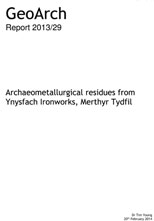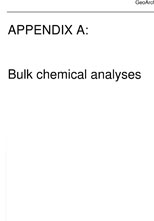The Glamorgan-Gwent Archaeological Trust Ltd.
Archaeology in Wales
Post-excavation metallurgical research
The analysis of the structures, finds and samples taken during the excavation has revealed new information about the iron-making processes, particularly the refining of cast iron into wrought iron. As no modern analytical work had previously been undertaken on the residues from the refining process, the first aim was to establish which of the residues were indeed from the refining process. The key discovery was one slag flow that had accidentally descended into one of the drains, but which must have originated from the adjacent furnace. The drains also contained an enormous quantity of micro-spheroids (tiny balls of slag up to 7mm in diameter). Analysis of these materials confirmed that they were indeed from the refining process. An important specialist analysis report has been prepared on the metallurgical residues by GeoArch
Contemporary accounts suggested that the oxidation of silicon from the grey cast iron was the primary purpose of refining (silicon acts to promote the formation of graphite in cast iron rather than iron carbides, so removal of silicon, together with quenching, aids the formation of a white cast iron rather than grey). The new investigations suggest that the oxidation of phosphorus might have been more important – and excess phosphorus would produce the symptoms described in the failed puddling experiments of the 1780s. Below one of the walls of the refinery building, a small group of fragments of cast iron was recovered, at least one is white cast iron and may be a rare surviving fragment of 'finers metal'.
The discoveries made during the excavation together with modern analytical techniques are for the first time allowing better understanding of the critical chemical processes of the Welsh process for the conversion of cast iron to wrought iron. The exact nature of the chemical changes would have been unknown to the ironmasters of the eighteenth and early nineteenth centuries. Today, this knowledge allows us to better understand the processes behind the high quality iron that Merthyr Tydfil exported to the world. The refinery at Ynysfach is the first refinery employing the Welsh process to have been excavated and interpreted archaeologically.








